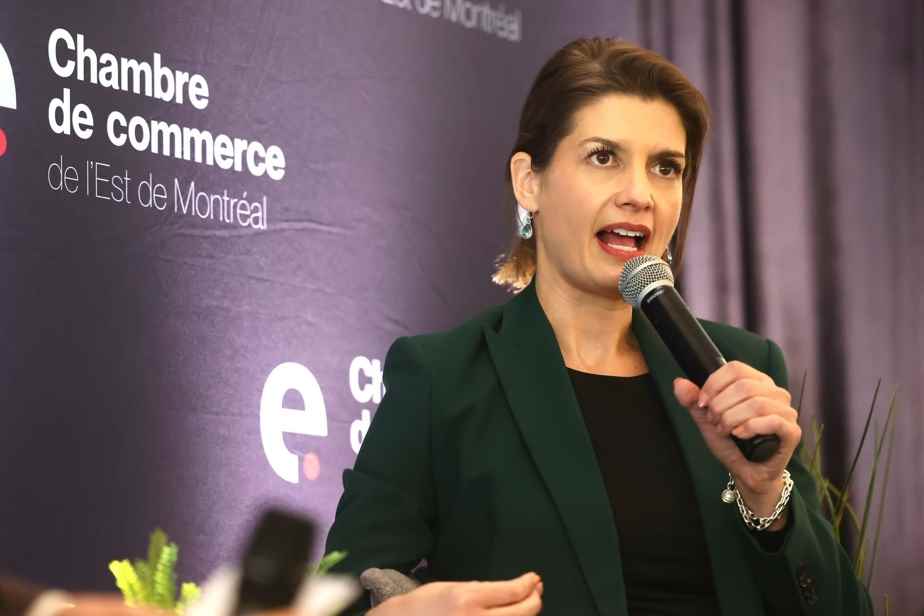The Minister of Transport, Geneviève Guilbault, still dreams of a possible extension of the REM from the East to the city center, excluded from the project since the withdrawal of CDPQ Infra. But it would be done in a second phase of work, she maintains, recalling that it will be necessary to look again at the mode of insertion and the layout.
“Whatever happens, the connection with the city center will never be impossible in a second time if necessary”, admitted Mme Guilbault on Monday, while giving a speech to the East Montreal Chamber of Commerce (CCEM).
She was responding to the remarks of the CEO of the Chamber, Jean-Denis Charest, who argued at the microphone a little earlier that “the uncertainty” surrounding the link with the downtown area of the future REM de l’Est raises certain fears and concerns. in the business community, who want to see this stretch come to fruition.
Called to clarify her thoughts in a press scrum, the minister remained cautious, assuring on several occasions that she still has nothing to announce. “That said, it’s not a closed system. Public transit projects, sometimes, are done in phases. These are things that can continue, can be interconnected, ”she nevertheless conceded, adding that the same goes for the tramway in Quebec.
For the connection with the city center to become “acceptable”, it will be necessary to review several parameters, believes Mme Guilbault. “The mode of insertion and also of course the layout become determining subjects in terms of social acceptability. This will be a question to be asked with all stakeholders,” she continued.
The “capable” green line for now
At the end of January, The Press reported that the green line of the Montreal metro should welcome at least 10% more ridership and see its transfer stations explode in number of users if the REM de l’Est does not obtain a connection with the city center .
According to the committee’s preliminary report, an Eastern REM without a connection to the city center would contribute to a daily overload of at least 4,000 passengers during peak hours, or 10% more than the line’s normal traffic. green, whose ridership has already increased since the work in the La Fontaine tunnel. At Assomption station, the increase would be more marked: the number of peak times would jump from 2,500 to 18,000, an increase of 620%. In the east branch, in the axis of rue Sherbrooke Est, 60% of users would take the green line at one time or another.
On Monday, Minister Guilbault reiterated that “the green line is capable of absorbing the traffic that will come” from the REM de l’Est. She quoted a recent study by the Société de transport de Montréal (STM), which states that “the metro’s green line still has a significant residual capacity which should be sufficient for at least ten years”.
In the study, however, it is specified that the REM will make it “necessary to accelerate the deployment of new means to increase capacity”. The extension of the blue line, for which the STM has just announced under a partnership with Ivanhoé Cambridge that a station will indeed be located at the Galeries d’Anjou, will also be able to unload the REM from the Lacordaire station, said the minister.
“We want to do things right. I am one of those who thinks that, as long as you do a project, you might as well do it in the most optimal way possible”, persisted Mme Guilbault, saying he wanted to avoid “end of the candle savings”. “We want a budget that stands and is realistic,” she maintained.
“Accelerate construction sites”
During her speech, the Minister of Transport also mentioned that Quebec must “find a way to speed up construction”, particularly in the city center, where a third of the orange cones would be “useless”, according to a recent report by the Chamber of Commerce of Metropolitan Montreal (CCMM).
“We have a lot of infrastructure projects to do, and we are sure that there is a way for it to take less time, and therefore for it to be cheaper […] so that it puts less pressure on public finances, ”she argued.
More broadly, Quebec says floor in priority on “what costs nothing” to reduce the number of orange cylinders in the streets of the metropolis. “We are thinking with the mayor [Valérie Plante] to know if we can play on regulations, ways of doing things. If we can, let’s do it, and it will improve people’s quality of life,” said Ms.me Guilbault on this subject, saying however that he needs the support of the unions and the construction community in the first place.
